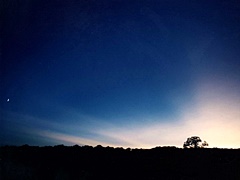
Welcome to Hemlock and Canadice Lakes!
Barns Businesses Cemeteries Churches Clinton & Sullivan Columns Communities Documents Events Time Line Fairs & Festivals Farm & Garden Hiking Homesteads Lake Cottages Lake Scenes Landscapes Library News Articles Old Maps Old Roads & Bridges Organizations People Photo Gallery Podcasts Railroad Reservoir Schools State Forest Veterans Videos
|
“Nature in the Little Finger Lakes” by Angela Cannon Crothers |
|
|
Both Ends of the Day Angela Cannon-Crothers May 2017 The sky grows cobalt overhead. The hillside before me is an outline framed in glowing orange. I can still make out features pretty clearly though the sun has set. I know I have about a good half hour of light left before darkness reigns. A mosquito comes in, then another, and another. I hear the flute-like call of a hermit thrush just beginning. Dusks and dawns... Twilight is the shift, a unique framing of light, a changing of the guard. For many animals, twilights do more than announce the beginnings of diurnal or nocturnal activity. For some species, twilight itself is their niche. Creatures of dusk, dawn, or both are termed “crepuscular.” They are specialists among specialists, avoiding predators, or finding their own space to be one. For a month this spring, in the transitional forest behind my house, the long-billed woodcock has been doing his courtship “peenting” during twilight times. He then does his spiraling, high-pitched wing-whirring dance so high up in the sky it seems he is attempting to fly to the glowing moon. Woodcocks are crepuscular birds, as are the nightjars, night hawks, chimney swifts, and most thrushes. Crepuscular animals opt for more secrecy, safety, or comfort, without turning nocturnal. The beaver, for instance, is busiest during the hours of dawn and dusk. Other crepuscular animals include bears, opossum, skunks, bobcats, many rodents, some bats, and deer (the later having once been entirely active in the daytime and adapting their activity to this time). Certain owls are more vespertine crepuscular (active at dusk) than nocturnal, as are many insects like fireflies, compost flies, some moths, and several species of mosquitoes. Our pets are typically crepuscular, which makes sense when you think of the typical lifestyle for when their human is home. Duration of twilight (and there are three stages) can last from 30 to 60 or more minutes, depending on the season and your location on the earth. Crepuscular wildlife benefit in many ways—there is a heightened sense of smell from the humidity rising off the ground, and sounds are amplified as the winds die down with a setting sun. Some crepusculars, like insects such as mosquitoes, benefit from being able to navigate better in the polarized (UV) light spectrum, which strengthens with the low angle of the sun. The annoyance and buzz of the mosquito is typically more prominent during dusk and dawn. Hot daylight hours can cause mosquitoes to desiccate, so most species lay low during a hot sunny day. Mosquitoes also see better in UV light rather than with the daylight’s infra-red spectrum. UV light vision aides mosquitoes in finding water. Twilight CO2 concentrations change while the humidity increases, which makes finding a food source easier, too (yea, us!). Mosquitoes also avoid the heaviest bird predation in twilight. In UV light, color—at least as we know it— doesn’t exist. Imagine a highly contrasted black and white photo and what you notice are patterns. In flowers, for instance, a bull’s eye pattern emerges with intricate detail that is less evident in full blue range infrared colors. UV vision is a world of patterns and shapes, a world of geometry. Many flowers contain hues in the UV spectrum that we cannot see, but that other animals—and insects—can. Twilight is the last glow as evening gains prowess. It brings the slap of a beaver’s tail, the electric scale of the veery thrush, the scent of skunk, and “twang” of a green frog. Twilight dawn grows from softness to vibrancy with an image of deer in the yard, or the cat incessant about going out. This space between night and day shimmers. Each degree of encroaching or dwindling light is a brief period of focus, embracing the moment that is giving way to the moment to come. A period of important work to be done in the limbo between darkness and light. Twilight is a time for making peace with all that came that day (or night) before, or a time of fresh beginnings. For crepuscular creatures, it is their place to shine.
|
||
|
Editor’s Note: Angela Cannon Crothers is a naturalist and writer who teaches at Finger Lakes Community College and with The Finger Lakes Museum. Here are some columns that she has written about the Little Finger Lakes. Her columns also appear in the Lake Country Weekender newspaper.
|
||
